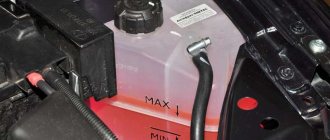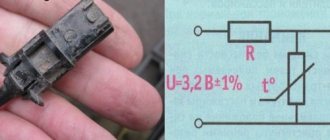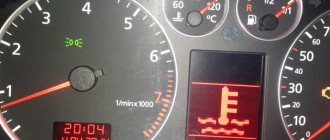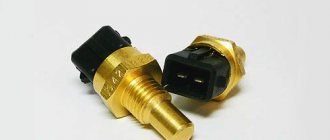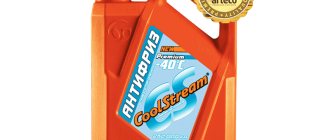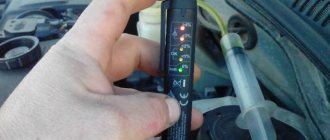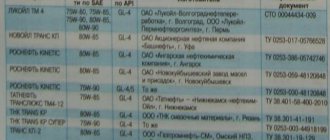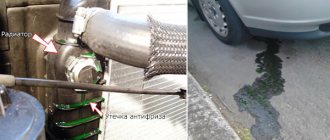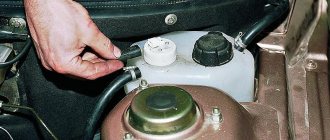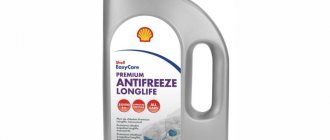The factory recommends changing the coolant every 75,000 mileage, and my mileage is already approaching 100,000, so I decided to do this operation. I bought Sintec antifreeze (2 packs), water (2 packs), and flushing agent (Felix RUR 95).
Armed with a search, I started looking for any records and didn’t find a damn thing (((The problem with replacement was the following: unscrew the drain plug (it’s simply not realistic to get there from above). I tried to create a topic on this problem, but there were no sensible answers. In the end I gave up for everything and decided to ask the Bosch service how much this procedure will cost, I quote the verbatim dialogue: - Hello, how much does it cost to replace the coolant in a Grant 8kl with air conditioning? - Hello. The work to replace the coolant on a Lada Granta 8 valve - 552 RUR Phone to make an appointment... We will be glad to see you at Bosch First - does this include flushing? - the cost of flushing work is 10,000 RUB - i.e. replacement is 552 RUB, and flushing is 10,000 RUB? - absolutely correct...
After this dialogue, I realized that I’m not going there anymore). I went to the “garage” service, all the work with washing cost 600 rubles (400+200). To drain the coolant from the cylinder block, we had to unscrew the starter (cable box), and to drain the coolant from the radiator, we removed the lower pipe from the radiator on the driver’s side (we didn’t even get to the drain plug from the bottom, the condenser is in the way).
| Year | Engine | Type | Color | Lifetime | Recommended Manufacturers |
| 2011 | for all | G12+ | red | 5 years | Frostschutzmittel A, VAG, FEBI, Zerex G |
| 2012 | for all | G12++ | red | from 5 to 7 years | Freecor QR, Freecor DSC, Glysantin G 40, FEBI |
| 2013 | for all | G12++ | red | from 5 to 7 years | FEBI, VAG, Castrol Radicool Si OAT |
| 2014 | for all | G12++ | red | from 5 to 7 years | Frostschutzmittel A, FEBI, VAG |
Volume of oils and fuel liquids LADA Granta
Motor oil is a key component in any car.
Without it, he will not be able to fully work. There is a wide range of lubricants on the market. They differ in brand, composition, viscosity and other characteristics that provide them with special chemical properties. When choosing consumables for LADA Granta, you must take into account the manufacturer's technical instructions. The functionality of the power unit depends on how correctly the fluid is selected. The role of lubrication for parts is great. It forms a special film inside the unit that protects it in adverse operating conditions. Oil helps reduce friction during operation. As a result, the service life of the components is increased.
The frequency of the procedure is provided by the manufacturer and is indicated in the relevant documentation. He recommends changing the engine fluid for the first time after two thousand kilometers. Subsequent replacement is carried out after 15 thousand km. The engine block will hold 3.5 liters of oil.
The lubricant consumption rate is 1 liter per thousand kilometers. In reality this value is not respected. Oil consumption is slightly lower and depends on the technical condition of the machine, its operating conditions, viscosity and quality of the fluid. Fast driving and frequent acceleration lead to increased oil consumption.
Filling volumes and oil names for different power units of the Lada Granta are shown in the table.
Source
Antifreeze Lux G12 and Premium G12+ from Sintec
The Sintek brand also produces all-season coolants Lux G12 and Premium G12+, which can be used in Lada Vesta cars with any type of engine. G12 antifreeze contains innovative carbon additives that improve thermal conductivity characteristics and increase the protection of metal surfaces from corrosion. The G12+ Premium composition is produced using carboxylate additives, which increase the service life of the coolant and form a protective film on the parts of the cooling system.
How to change coolant
You will need: Remove the crankcase protector (if necessary), a 13-inch wrench, a screwdriver, a clean cloth, an empty container, and new antifreeze.
Before draining the antifreeze from the Granta, you must first wait until the engine has cooled down, then:
- Remove the cap from the expansion tank.
- Place an empty container under the engine and remove the drain plug on the cylinder block.
- For VAZ-11183, VAZ-21116 and VAZ-11186 engines, access to the drain plug may require removing the ignition coil along with the bracket.
- Wait until the antifreeze has completely drained.
- Place a container under the engine radiator and unscrew the drain plug on the radiator.
- Wait until the coolant has completely drained from the cooling system.
- Screw the drain plug onto the radiator, replacing the rubber O-ring if necessary.
- Install the cover on the cylinder block.
Pour new antifreeze into the Grant cooling system until its level reaches 25-30 mm below the wall of the expansion tank. Then screw the tank cap back on. Start the engine and let it warm up to operating temperature (before turning on the fan). Then turn off the engine and, if necessary, add fluid to about. After a few days, check the fluid level.
After replacing the antifreeze, monitor the coolant temperature in the instrument cluster.
Choosing antifreeze to replace
Before adding antifreeze, you need to decide on its type. Remember that, ideally, you should always only use the coolant recommended by your vehicle's manufacturer. You will find detailed information in the manual or reference literature. In most cases, the use of coolants of different classes and brands is allowed. And when topping up, use only the one that was filled in earlier. Failure to comply with this rule may result in a malfunction of the cooling system.
As for the Hyundai Solaris car, the following types of antifreeze can be used for it:
- G-11. Such compositions belong to the hybrid group - hybr{amp}gt; If it is necessary to add more than 30% of the total volume, then it is better not to add antifreeze, but to completely fill in new fluid.
Accordingly, only hybrids can be mixed with hybrids, carboxylates with carboxylates, and lobrides with lobrides. Mixing antifreeze of different classes is strictly prohibited. The only exception is G12 class antifreeze, which can be added to G11 and G12 fluids. Also, you cannot add domestic “Antifreeze” to antifreeze, since their chemical compositions are very different.
Remember that antifreeze is sold in stores in two formulations - completely ready for pouring into the cooling system and as a concentrate. Pay attention to this, since pure concentrate cannot be added to the existing coolant in the car system. Even if they belong to the same class.
When choosing, do not neglect the color of the liquid. The color is intended to indicate certain properties of the antifreeze, so replace it only with an option with an identical color.
Recommended brands of antifreeze include the following products:
- “AGA 003Z” (temperature minus 40 degrees), has a red color, costs approximately 1 thousand rubles. for a 10 liter container.
- “Professional Premium” belongs to the “G-12” category, and the cost of a similar “tank” reaches 700 rubles.
- “SINTEC LUX G-12” is also characterized by a red tint and costs from 1 thousand rubles. for a volume of 10 liters.
- “FELIX Carbox-40”, a canister of the same volume with red liquid will cost the owner from 950 rubles.
- "NIAGARA", substance "G12"; for a volume of 10 liters you will need to pay at least 800 rubles.
- “Arctic Circle”, a substance with similar parameters; A 10-liter container costs at least 700 rubles.
Antifreeze from the above-mentioned manufacturers has proven itself quite well, so you can purchase it without the slightest hint of doubt.
How to remove air from the Granta cooling system
- Allow the engine to cool.
- Unscrew the cap of the expansion tank.
- Start the engine and let it run for 3-5 minutes.
- Close the tank lid.
- To help the system fill better without air pockets, periodically squeeze the radiator hoses with your hand.
By the way, do you know what kind of antifreeze is poured into the Granta?
- Ratchet
- Extension
- Head 8 mm
- Head 10 mm
- Head 13 mm
- Funnel
Spare parts and consumables:
- Coolant 8 l
- Technical capabilities
- Rags
Engine cooling fluid should be changed every 75,000 km (75,000 km) or five years, whichever comes first, according to the maintenance schedule. It is more convenient to change the coolant when the car is installed on an inspection ditch or on an overpass. If the engine is hot, you need to let it cool, then relieve excess pressure in the cooling system by unscrewing the expansion tank cap.
Drain the coolant
1. Remove the engine compartment center wing as described in this article.
2. Place a large container with a minimum capacity of 6 liters under the drain hole at the bottom of the right radiator reservoir.
3. Unscrew the plastic drain plug of the radiator tank and drain the coolant into a container.
To reduce the intensity of liquid drainage, tighten the expansion tank cap tightly at the initial moment.
4. To increase the intensity of liquid drainage, unscrew the cap of the expansion tank.
5. To drain the coolant from the engine cooling jacket, place a container under the drain hole located at the front of the cylinder block, under the ignition coil.
6. Using a 13-point socket, remove the cylinder block drain plug and drain the fluid into a container.
Refilling the cooling system
1. Install the radiator and cylinder block drain plugs.
The cylinder block drain plug has tapered threads, so screw in and tighten until resistance to rotation increases sharply.
2. Fill the cooling system with liquid through the expansion tank (at this stage the system contains approximately 6-7 liters of liquid).
3. Start the engine. Move the air temperature control knob in the central heating and ventilation system to the red sector of the scale.
4. With the engine running, tighten all coolant hoses tightly several times one at a time.
This will help the fluid fill the system and force air out of it.
5. When the coolant level in the expansion tank drops, return it to normal and tighten the tank cap.
When the engine warms up, the outlet (lower) radiator hose should be cold for some time, then quickly warm up, which will indicate the start of fluid circulation in a large circle.
6. Check the operation of the heater inside the car. Stop the engine while waiting for the cooling fan to turn on.
How many liters of antifreeze or antifreeze are poured into the cooling system in a VAZ 2110
There are many components, mechanisms and systems in a car. And in the article it is worth considering the car’s cooling system. Since the engine generates heat during operation, without a cooling system it will overheat very quickly. That is why this system was invented to balance the car between heat and cooling. Of course, like all other elements of the machine, the cooling needs to be serviced periodically. This includes replacing the coolant.
Antifreeze or antifreeze?
All generations of the domestic automobile industry need to be filled with only domestic antifreeze, and manufacturers fill it in at the factory. Antifreeze is an analogue of foreign antifreeze, but its cost differs significantly. Antifreeze also contains special additives that will protect against corrosion and foam formation.
Antifreeze contains ethylene glycol, which is diluted with distilled water, mixing 50:50. But each driver must dilute the antifreeze himself, but you can also fill in this composition. After all, water tends to freeze in the cold, and the less it is in the composition, the less the risk that antifreeze may freeze.
How many liters of antifreeze should I pour into a VAZ 2110?
Now it’s worth figuring out how many liters of antifreeze you need to fill in the VAZ 2110. And here the cooling system comes in second place after the fuel tank, while the manufacturer’s recommended number of liters is 7.8.
The very first cars of this generation had several types of engines, and the first one had 8 valves and was equipped with a timing belt. A little later, manufacturers released a new unit with 16 valves, but still in both cases the figure for pouring antifreeze does not change. And therefore, 7.8 liters must be poured into these two types.
This is all due to the fact that the block of these engines is the same, and the quantity can easily cool both the block and the engine itself.
What if you don’t add antifreeze/antifreeze?
Most often, antifreeze is presented in stores with a volume of 5 liters, and to replace it you will need two such canisters. After draining the used liquid, only 5 liters can enter the tank, and this is, in principle, normal; the rest can be added when the antifreeze passes through the entire cooling system. When the fluid has been replaced, you need to start the car and warm it up to a certain temperature, then turn it off and look at the expansion tank, all the fluid should go there. And if this happens, then you can add the remaining liquid.
Liquid level
Many people wonder how many liters of antifreeze to pour into a VAZ 2110, but not always to the fullest, this will have a bad effect on the cooling system. Since antifreeze produces a certain pressure, it needs a place to splash it out, so it can simply leak out. And if the valve on the tank lid is not working, then break it off altogether; it is best to fill at the average level, since with a small amount the engine overheats.
Air lock and methods of dealing with it
Now we’ve figured out how much antifreeze to pour into the VAZ 2110, now it’s worth talking about the air in the cooling system. It can only get there when new liquid is poured, and here you do not need to pour the entire canister at once, gradually at certain intervals.
Where to press to remove the traffic jam
How much to pour into the VAZ 2110, it was said 7.8 liters . There are situations when air does not leave the system, so you should put the car on a hill and unscrew the tank cap a little, then start the car and warm it up. After wearing gloves, since the system has heated up, you need to press slightly on the pipes to release all the air. And after that, you can add antifreeze again, to a certain level.
Answers (3)
It is recommended to fill the engine cooling system of this car with about 7.6 - 7.8 liters of coolant. The cooling system of the model can be filled with liquids of such brands as Tosol-TS FELIX, Cool Stream Standard, Cool Stream Premium, antifreeze SINTEC, Felix Carbox or G-Energy Antifreeze.
Tell me, what kind of antifreeze is best to pour into the grant? There are so many things listed above that I can’t choose the best one?
Buy some g12 or g12+ thread. It will be normal
Personally, I would not pour class G antifreeze into a grant. After all, this is the internal classification of the Volkswagen concern, which means that such antifreeze can only be safely poured into their cars. In general, the choice of antifreeze is simple. Absolutely always choose it with the approval of the car manufacturer and then everything will be ok. When they ask me which antifreeze is better to choose, I always answer the same thing - choose the original. Now I will answer the same. For grants, the original is coolstream nrc. Take it calmly, fortunately, it is easy to find in retail. The cooler is excellent, in all the years of my work in the service, no one has complained about it. And all because it has the approval of the car manufacturer (not surprising, since it is poured at the car plant), and the additives in it have passed the strictest European control.
And in my Grant it says (in my passport) to fill in G 12 ++, I bought AGA 12 ++, should I drain it? It says - ideal for all Lada brands.
On my grant on the cooling tank the recommendation is to use SINTEC antifreeze
On cars of the Lada Granta family with an injector, a closed-type liquid cooling system is pre-installed. Antifreeze circulates through the system forcibly, performing two functions: removing excess heat and lubricating units.
The standard operating temperature of the cooling system is 94 – 99℃, regardless of the actual configuration of the car, body type, and other technical characteristics.
How often should this be done?
There is a general recommendation regarding how often antifreeze should be changed. It is recommended to change the refrigerant at least once every 2 years, or after 30 - 45 thousand km of vehicle mileage. The frequency of replacing “Antifreeze” must be observed taking into account the following indicators: the condition of the car, its mileage, the brand, manufacturer and composition of the coolant itself, as well as the solution used previously.
In this regard, the question arises, how often to change the coolant? It depends on the type of antifreeze, more on that below. In the meantime, let's consider situations when you need to change antifreeze urgently, without waiting for time to expire:
- significant clouding of the refrigerant, change in its color;
- the appearance of sediment, flakes, mechanical particles in the coolant;
- increased foaming;
- thickening - antifreeze becomes like jelly;
- significant reduction in fluid volumes;
- adding antifreeze of a different standard.
The last point is worth mentioning separately. Mixing incompatible classes of coolant - for example, silicate with carboxylate, can kill all the beneficial properties of these products. Often flakes and sediment form in this mixture, and it can also become very thick. Therefore, only coolants of the same class can be mixed and added.
It is also worth saying that in older cars with high mileage, antifreeze requires more frequent replacement than in new ones. This is due to the fact that corrosion spots inevitably form in the engine over time. Antifreeze tries to neutralize them, absorbing rust particles and losing their beneficial properties. In this case, the need for replacement will be indicated by a rusty tint of the liquid.
Antifreeze manufacturers always indicate on the product packaging the recommended replacement period. Usually, after this period, the first warning signs appear, signaling a deterioration in quality.
These intervals depend on the production technology and the liquid standard (if you use the classification of antifreeze from the Volkswagen concern, borrowed by many manufacturers):
- G11. This standard includes traditional antifreezes. They use inorganic additives - silicates and other substances. Their peculiarity is that they form a physically tangible layer on the inner surface of parts, which prevents the formation of pockets of corrosion. If you do not change such antifreeze on time, this layer begins to precipitate, the protection deteriorates, and the fallen particles clog the system components. This happens faster than with other antifreezes. The recommended replacement interval is 2 years. TOSOL also has similar properties, so its replacement period will be similar.
- G12. This standard is used to designate coolants produced using organic (carboxylic) acid technology. The resulting liquid has excellent heat transfer properties and does not create any layer, like traditional ones. Its corrosion inhibitors act in a targeted manner. They are directed to where pockets of corrosion occur and prevent their further spread. However, over time, carbon fibers lose their grip, corrosion spreads, and the properties of antifreeze deteriorate. It is recommended to change them every 5 years. The same applies to improved carboxylate antifreezes - G12 and hybrid - G12.
- G13. This is the newest generation of coolants called lobrid. The main difference is that it is based on propylene glycol (the rest use ethylene glycol), a more environmentally friendly and more reliable base. Otherwise, they are similar to carboxylate ones. Such fluids have the longest service life - from 5 to 10 years, and some manufacturers recommend not changing the coolant at all throughout the entire service life of the cooling system.
Elements of the Lada Granta cooling system
- stove heater radiators;
- electric pump;
- engine;
- throttle assembly;
- thermostat;
- antifreeze temperature sensor;
- overheat indicator;
- viscous fan drive coupling;
- fan;
- radiator cap;
- radiator;
- expansion tank cap;
- expansion tank;
- water pump;
- drain valve of the lower circuit.
And also, pipes of the Lada Granta cooling system, metal clamps - ties.
Thermostat
The cooling device on the Lada Grant is the main link in the chain. Performs the function of a valve that redirects the flow of antifreeze from a small to a large circle. When the operating temperature is below 94°, the thermostat is in the closed position. The liquid circulates in a small circle without “entering” the radiator.
New thermostat
According to this movement pattern, the heating of the liquid occurs many times faster. When the antifreeze heats up, the valve opens slightly, starting circulation in a large circle into the water jacket line.
Most often, a thermostat malfunction is associated with its boiling or jamming due to overheating. The part cannot be repaired; it must be replaced with a new, serviceable one.
Water pump (pump)
Forces antifreeze to circulate through the jacket (system). Structurally, the pump is located inside the engine, closer to the gas distribution mechanism (GRM). Moreover, it has a common drive with the timing belt.
Water pump
The average service life of the pump is 80 – 85 thousand km. Due to the frequent violation of regulations by the driver, the purchase of cheap analogues instead of original spare parts, the part wears out prematurely.
Radiator and fan
The radiator is designed to cool antifreeze. The standard fan also performs this function, but only after the operating temperature reaches a critical level of 100°.
Fan
How quickly the fan activates depends on the health of the temperature sensor. The latter monitors the degree online and sends the readings to the electronic engine control unit (ECU) to adjust the operation of the mechanisms.
Failure of the sensor leads to boiling of the engine. Many car owners have encountered this problem.
Connecting hoses and water jacket
Hoses serve as a link, connecting all mechanisms to each other. Frequent malfunctions are associated with a violation of the integrity, tightness of the system, and low levels of antifreeze.
Cooling system pipes
Reviews
| Prevention, replacement with new ones | ||
| Whistle from under the expansion tank cap | Inspection | Replacement |
| The motor takes a long time to reach operating temperature | Inspecting the antifreeze level | Adding fluid, replacing the thermostat with a new one |
| The temperature sensor systematically shows false data | Inspecting the electrical circuit, measuring the sensor resistance | Replacement with new one |
| No circulation in the main line | Inspection through the expansion tank with the engine running | Washing, removing air pockets |
| № | Positive |
| 1. | Vasily: I’ve been driving a car for a year and a half, no comments. I carry out technical inspections in a timely manner, fill up with high-quality fuel and oils, and have a moderate driving style. |
| 2. | Gennady: at 50,000 km the standard thermostat jammed, replaced it with a new one under warranty. There were no more breakdowns, the machine works like a watch. |
| 3. | Kirill: the rubber pipe burst once where it was fixed with a clamp, I think it was my mistake, I overtightened it. I'm happy with the build quality, no complaints. |
| 4. | Vladlen: I’ve heard negative reviews about Granta, saying that the system is often overstuffed. This happens, but extremely rarely, the defect is not widespread. |
| 5. | Ignat: in order for the machine to work properly and the parts to last longer, it is necessary to treat it with care, care for it, and maintain it. |
| 6. | Dmitry: Six months have passed since the purchase of the car, so far the work is perfect, no investments except for the purchase of consumables. |
| 7. | Valentin: I am satisfied with the build quality of domestic transport; breakdowns do occur, but they are insignificant and can be easily repaired. The engineers managed to combine good quality at an affordable price. |
| Negative | |
| 1. | Ivan: negative experience during operation of the car, already at 45,000 the thermostat jammed, then the bearing flew off. The model is still crude, there are many shortcomings, the manufacturer does not strive to quickly eliminate them. |
| 2. | Vladimir: the build quality is low, after two months of using the car, the rubber pipe cracked and antifreeze began to leak. |
| 3. | Vyacheslav: Lada Granta or Renault Logan - obviously the latter. The manufacturing quality of the French automobile industry is an order of magnitude higher than its domestic counterpart. |
Conclusion As practice shows, most calls to service stations are caused by a jammed thermostat on the Lada Grant. The reasons are different. The factor of manufacturing defects cannot be ruled out, but the fault also lies with the owner of the car.
Buy original spare parts, maintain your car in a timely manner - then the number of breakdowns will be reduced several times.
Motor oil is a key component in any car. Without it, he will not be able to fully work. There is a wide range of lubricants on the market. They differ in brand, composition, viscosity and other characteristics that provide them with special chemical properties. When choosing consumables for LADA Granta, you must take into account the manufacturer's technical instructions. The functionality of the power unit depends on how correctly the fluid is selected.
The role of lubrication for parts is great. It forms a special film inside the unit that protects it in adverse operating conditions. Oil helps reduce friction during operation. As a result, the service life of the components is increased.
The frequency of the procedure is provided by the manufacturer and is indicated in the relevant documentation. He recommends changing the engine fluid for the first time after two thousand kilometers. Subsequent replacement is carried out after 15 thousand km. The engine block will hold 3.5 liters of oil.
The lubricant consumption rate is 1 liter per thousand kilometers. In reality this value is not respected. Oil consumption is slightly lower and depends on the technical condition of the machine, its operating conditions, viscosity and quality of the fluid. Fast driving and frequent acceleration lead to increased oil consumption.
Filling volumes and oil names for different power units of the Lada Granta are shown in the table.
Cooling system Lada Granta - 8 and 16 valves, with and without air conditioning
| Name | Peculiarity |
| The engine cooling system (hereinafter referred to as SOD) of the Lada Granta family is completely identical to the Lada Kalina | Heater radiator, single-pass, low resistance, aluminum, brazed, high efficiency |
| The radiator is built into a small circuit, unlike previous generations | |
| The thermostat has one valve, not two, as was previously the case | |
| The thermostat controls the flow of antifreeze through the radiator | |
| The interior heating system has been improved by removing more heat from the heater radiator | Increased flow of antifreeze through the radiator at a small circle of rotation |
| One-way passage pattern instead of two-way | |
| Aluminum pipes are flat instead of cylindrical | |
| Soldering is used at all stages of articulation | |
| No chance of airing | Changing the angle of inclination of the antifreeze supply/return lines |
| Improved aerodynamic performance | |
| Fine tuning of engine operating temperature | |
| Increased operational efficiency due to | Changes in ignition timing |
| Economical fuel consumption mode |
Checking the radiator for leaks
The diagnostic process is not at all complicated; we carry it out ourselves, and if you don’t have free time, visit a service station to have the work performed by professionals.
Checking the radiator from the engine compartment side
- We place the car within the perimeter of the repair area, on the inspection hole, and open the hood.
- From the engine compartment side, we inspect the surface of the radiator for drips and traces of antifreeze (antifreeze) leakage.
- We carry out similar actions from under the bottom of the car;
- We inspect the antifreeze supply/return lines, upper and lower circuits.
The most common places for depressurization: corners around the perimeter, joints, ties with clamps.
How to drain antifreeze from the cooling system of a Lada Granta
- The hood is open, the car engine has cooled down to a safe temperature so as not to damage the skin.
- We unscrew 6 screws from under the bottom and remove the oil pan protection.
- Unscrew the drain plug in the lower circuit of the radiator.
- At the same time, unscrew the drain plug on the wall of the cylinder block. We substitute the container.
We unscrew the plastic drain plug of the radiator tank.
Note to the driver!
The Lada Granta version has 8 valves. Place the container for testing below the ignition module, under the cylinder block (nut at “13”).
In the Lada Granta 16-valve, we first dismantle the starter, since it prevents free access to the plug. If you do not remove the starter, antifreeze will flood the part, temporarily rendering it unusable.
- After the liquid is completely drained from the water jacket, screw in the drain plugs. Fill in new antifreeze in a volume of 7.5 liters to about or 8.0 liters to the recommended average level.
How to remove air from the cooling system of a Lada Granta
There are several effective ways to bleed air from the system.
Purge using a pump
Method No. 1
- We move the stove heater lever to the “Maximum” position (car interior). Be sure to follow basic safety measures and place wheel chocks under the rear wheels.
- Unscrew the valve cover, having first removed the decorative trim.
- Using a screwdriver, loosen the clamp on the throttle body fitting and remove the rubber pipe..
- Unscrew the cap on the expansion tank
- Through a gauze bandage, blow air through your mouth in the direction of the expansion tank.
It is important not to overdo it, as you can start a new portion of air again.
Method No. 2
- We warm up the car to 40 - 45°, turn off the engine.
- Unscrew the throttle clamp and remove the hose.
- If liquid leaks out of the hose, put it back on, otherwise wait until the air comes out.
- We assemble the structure in reverse order.
One time is not always enough to remove air. We repeat the procedure as necessary.
Method No. 3
- We drive the front wheels of the car onto a hill so that the highest point in the cooling system is the “plug”.
- We twist the cap on the expansion tank and the cap on the radiator.
- We start the engine, it runs at idle speed.
- We warm up the car to an operating temperature of 40 - 45°.
- As soon as the antifreeze level begins to decrease, we replenish the missing amount.
- We repeat the procedure until the maximum amount of plug comes out.
- Screw the lids on.
An air lock in the system can not only reduce the efficiency of the stove heater, but also negatively affect the operation of the engine as a whole. After the blockage is cleared, systematically inspect the equipment.
How to flush the cooling system on a Lada Grant
Violation of the deadlines for replacing the fluid, the purchase of cheap analogues contributes to the formation of sediment in the line and clouding of the antifreeze.
Due to the loss of chemical and physical properties, the water jacket of the power unit is subject to corrosion and peeling.
A constantly elevated operating temperature is the first sign of contamination, deposit formation, or thermostat malfunction. The manufacturer recommends cleaning the lines every 50,000 km. Replacement of antifreeze after 75,000 km.
The volume of the Lada Granta cooling system is 8.0 liters.
After how many kilometers should you change the antifreeze in your car?
Different brands of cars require filling with liquids on different bases. Let's consider how often you need to change the coolant in a car.
- Kia Rio: scheduled replacement occurs once every 120 thousand km, or 8 years.
- Hyundai recommends replacing the technical fluid of the Solaris model after 200 thousand km or 10 years of use.
- On the Lada Grant, replacement is carried out after 75 thousand kilometers or after five years of operation.
Next, how often to change VAZ antifreeze. On a car, the manufacturer recommends replacement every 2 years or 60,000 km.
- Renault Logan: the composition should change after 6 years (90 thousand km).
Typical malfunctions of the Lada Granta cooling system
| Malfunction | Diagnostics | Remedy |
| The fluid level is below the permissible norm in the radiator | Inspection of the highway for integrity | Topping up |
| The motor is overheating | Thermostat is stuck | Replacement with new one |
| No pressure in the cooling system of Lada Granta | Channel clogging, depressurization | Replacing the water pump |
| The electric fan does not turn on when the temperature limit is reached | Checking the integrity of the electrical circuit and fuse |
Checking the Lada Granta fan circuit


